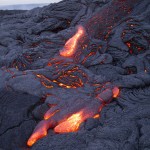Note: This post has been revised based on current conditions and access. You can see the revised post here.
Getting close to flowing lava is a great experience, but one that is fraught with risks. Sometimes the lava is relatively easy to access, near a road or developed trail. Most of the time it takes a serious hike across the old flows to get near, an arduous trip with no trail or map to guide you.

My most recent hike was my fifth trip out to the flowing lava, requiring my longest hike over the flows to date at just under three miles each way. OK, maybe I am not yet a veteran, but these trips have taught me a lesson or two. Going onto the lava is an inherently risky proposition and one must accept that risk. With a little knowledge and preparation the risks can be mitigated. Besides, the reward is spectacular!
You can take my word for it, or perhaps read the same information from someone who has been out far more than I. We will all tell much the same story.
Where
The easiest place to get to the active flow is when it is on the coastal plain between Kalapana and the end of Chain of Craters Road in Hawai’i Volcanoes National Park. Depending on the location of the current flow you can hike in from the end of highway 130 on the Kalapana side or from the end of Chain of Craters Road in the park.
Coming in from the Kalapana side usually keeps you upwind of the plumes of volcanic gasses. The tradewinds usually blow east to west across the island. The trades also moderate the heat of the lava plain, without wind conditions on the lava can be oppressive. If the trades weaken or pause you may want to postpone your hike.
Of course, the flows are not always there. You can check for the current locations of the flows on the USGS Hawaiian Volcano Observatory website. There you can find a daily report of activity. For the last 20 years, since the eruption of Pu’u O’o, the flows have been on the plains at least part of the year, almost every year.
EveryTrail – Find the best Hiking in Hawaii
Depending on the location of the lava it can be anywhere from a few hundred yards to several miles to reach the lava. Given the nature of the old flows it is necessary to plan for about one mile per hour travel time across the flows, particularly during a night approach. You may be able to go faster at times, when you can, count yourself lucky.
When
I prefer a predawn attack. There is some logic behind this… Hiking out in the dark will be much cooler and the lava far easier to see. At night the breakouts and other activity is easier to spot, the bright golden glow visible from a mile away or more. In full sunlight the active lava is difficult to locate, you could be within yards of a breakout and be unaware. You can then take advantage of dawn light for excellent photographic conditions, the rosy glow of hot rock showing up well in low light conditions. After sunrise, you have full light for the hike back and you can usually beat the brutal heat of the afternoon on the flows.
This does mean crossing the flows in the dark. Bright flashlights and a slow and careful pace is required. I carry at least two flashlights and spare batteries. The bright LED lights that are available these days are excellent, I have a small dive light that can output nearly 1000lm. A full Moon can also assist, the moonlight making it much easier to see across larger distances thus allowing you to plan further ahead and keep your bearings.
What to Carry
Carry plenty of water. I can not stress this enough! It gets hot on the black rock under a tropical Sun. At least a couple liters per person, more if the distance to be covered is greater. You will use that water much more quickly than you planned. I like to use a hydration pack with a sipping tube, it really helps to keep sipping water as you hike along.
I recommend a pair of leather gloves to wear as you cross the fresh flows. In the likely case of a slip or stumble, you can put down a hand without that hand being shredded on the glassy surface. A hat and sunscreen is also on the necessity list. The weather can vary from blazing sun to heavy rain in short order. Some sort of rain-gear is useful. I keep an old military rain poncho in my pack, it keeps me dry without being stifling in the warm tropical air.
A GPS or GPS app for your phone is very useful. Lately I have been playing with an app called EveryTrail that has some nice features. Getting lost is difficult with the ocean on one side and the pali on the other. But a GPS can indicate how far you have come as well as the route and distance back to the vehicle. You can also use GPS to stay on the old highway right-of-way to avoid trespassing on private land.

Footwear
Proper footwear is a must! Sturdy boots or shoes required to traverse the fresh lava surface. The freshest lava is covered by a layer of volcanic glass shards that crunch underfoot at every step. Occasionally bits of rock that looked solid enough will give way and collapse. I have seen folks start out onto the lava in sandals or rubbah slippahs, they quickly turn back for good reason.
I have done the hike in Teva trail sandals, but only for shorter distances. Without proper side protection I really do not recommend it.
You may not want to use the new boots either. Your footwear will look a bit chewed-on after this hike as the rough lava takes its toll. The last trip out I wore my older boots, knowing they get a bit worn by the hike. halfway back the whole toe section gave way with a crack through the sole. Luckily I had a partial roll of duct tape in my pack, I was able to patch up the boot enough to continue on with little trouble.
Other Precautions
Carry a cell phone. Coverage can be spotty on the coastal plain, but there is usually a signal. If you do require assistance it is possible to make the call to get help.
This is Puna, the “interesting” side of the island. Leave nothing of value in the car, even when parking at the county viewing area.
Check out the National Park Service video embedded here. It says many of the same things, with a few other precautions about the hazards of the ocean entry. There are also some simple, but reasonably accurate animations that are quite informative.
If you do take the hike, take care and enjoy the experience. I am already planning my next trek out onto the lava. This is one of the best places in the world to witness the raw power of nature.

